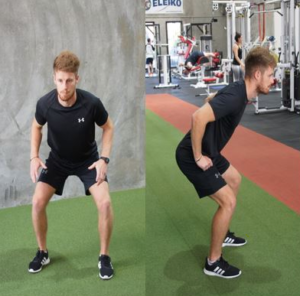A proper athletic stance is a foundation of efficient movement. Understanding the components of a proper athletic stance allows coaches, parents, and athletes to practice and develop the skills required to naturally achieve the position during sports activities.
The basics of the athletic stance are as follows:
- Feet hip-width apart to shoulder-width apart
- Quarter-squat position
- Bodyweight evenly distributed through both feet
- Center of gravity directly above base of support
- Shoulders level
- Torso flat and at a slightly bent from vertical (75 degree) incline.

The key “checkpoints” in the athletic stance are the hinge (slight bend) in the hips and flexion (slight bend) in the knees. The hips should also be slightly “open” resulting in the knees facing slightly outward – in short, the quarter-squat position.
The athletic stance creates tension much in the same way a spring has tension when it is slightly stretched. Sports scientists use the phrase “stretch-shortening cycle” (or SSC) to describe the effect associated with the athletic stance and similar body positions. In the athletic stance, the muscle groups of the calf, hamstrings, and glutes (buttocks) are slightly stretched, creating tension and stimulation of the muscle elements. When the muscles are then tightened (hips, knees, ankles are straightened), the energy is released. Research has shown that the use of the SSC effect creates greater power than a simple muscle contraction.
A number of athletic elements of soccer are positively affected through the use of an athletic stance:
- Lateral movement
- Acceleration and deceleration
- Dribbling and turning
- Jump height
- Landing mechanics
- Small-space movements and physical reaction time
The athletic stance supports loading of force through soft-tissue rather than directly in joints (specifically, the knee joint) – reducing the risk of placing the knee in an unsafe position which may result in injury.
In addition, the athletic stance is a basic movement in resistance power/strength activities such as deadlifts, squats, and kettlebell exercises.
The use of the athletic stance is common in the following situations:
- Carrying the ball in tight spaces
- Executing feints/moves over the ball
- Lateral (side-to-side) movements
- Backpedaling
- Diagonal forward/backward movements
The athletic stance is a critically important part of 1v1 defending, where the player must be able to respond to moves initiated by the attacker while staying engaged and within a pressure distance.
Maintaining the position during movement – avoiding crossing the feet, standing tall too early, putting too much bodyweight on one foot, or losing balance – are all important parts of effective performance in the game.
Video demonstration
References
Howard, R. (2018). The ABCs of Long-Term Athletic Development. Retrieved 28 January 2018, from https://www.nsca.com/Education/Articles/The-ABCs-of-Long-Term-Athletic-Development/
Miyaguchi, K., & Demura, S. (2008). Relationships between muscle power output using the stretch-shortening cycle and eccentric maximum strength. The Journal of Strength & Conditioning Research, 22(6), 1735-1741.
Suter, E. (2017). Total Youth Soccer Fitness.